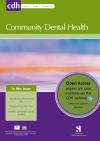Community Dental Health

- Cover Date:
- December 2014
- Print ISSN:
- 0265 539X
- Vol:
- 31
- Issue:
- 4
Associations between schools’ guidelines and pupils’ smoking and sweet consumption
© BASCD 2014 doi:10.1922/CDH_3358Kankaanpää06
Associations between schools’ guidelines and pupils’ smoking and sweet consumption
R. Kankaanpää, M. Tolvanen, J. Anttila and S. Lahti
Objective: The aims were to find out if schools’ sweet-selling was associated with pupils’ sweet consumption, and whether the school’s guideline about leaving the school area was associated with pupils’ tobacco and sweet consumption. Methods: Two independently collected datasets from all Finnish upper secondary schools (N=988) were linked together. The first dataset on schools’ sweet-selling (yes/no) and guideline about leaving school area (yes/no) was collected via school principals in 2007 using an Internet questionnaire with a response rate of 49%, n=480. The second dataset on pupils’ self-reported: weekly school-time (0, never; 1, less than once; 2, 1–2 times; 3, 3–5 times), overall sweet consumption frequencies (1, never; 2, 1–2 times; 3, 3–5 times; 4, 6–7 times) and smoking and snuff-using frequencies (1, never; 2, every now and then; 3=every day) was collected in 2006-2007 in the School Health Promotion Study from pupils. An average was calculated for the school-level with a response rate 80%, n=790. The total response rate of the linked final data was 42%, n=414. Mean values of self-reported sweet and tobacco consumption frequencies between sweet-selling and non-sweet-selling schools and between schools with different guidelines were compared using Mann-Whitney test. Results: Pupils in sweet-selling schools and in schools without a guideline about leaving the school area, more frequently used sweet products and tobacco products than their peers in other schools. Conclusions: Schools may need help in building permanent guidelines to stop sweet-selling in school and to prevent leaving the school area to decrease pupils’ sweet consumption and smoking.
Key words: health promotion, oral health, sweets, soft drinks, smoking, adolescent, schools, Finland
- Article Price
- £15.00
- Institution Article Price
- £
- Page Start
- 234
- Page End
- 239
- Authors
- R. Kankaanpää, M. Tolvanen, J. Anttila, S. Lahti
Articles from this issue
- Title
- Pg. Start
- Pg. End
- The European Association of Dental Public Health conference resolution on the control of e-cigarettes; Or “You have to be a bit crazy to carry on smoking conventional cigarettes when there are e-cigarettes availableâ€
- 194
- 195
- Weighing up the Weighted Case Mix Tool (WCMT): a psychometric investigation using confirmatory factor analysis
- 200
- 206
- Dentists’ views on the effects of changing economic conditions on dental services provided for children and adolescents in Iceland
- 219
- 223
- Utilisation of oral health services provided by non-dental health practitioners in developed countries: a review of the literature
- 224
- 233
- The impact of oral health status on the Oral Health-Related Quality of Life (OHRQoL) of 12-year-olds from children’s and parents’ perspectives
- 240
- 244
